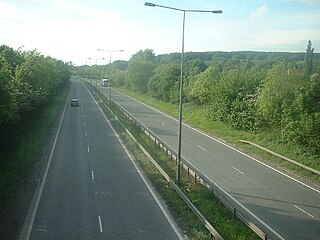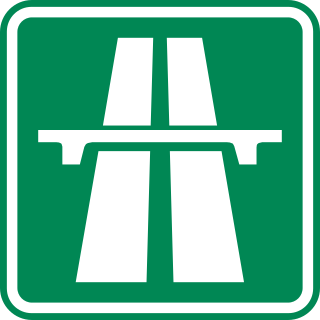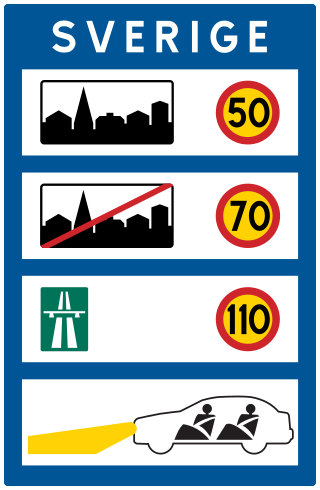
A dual carriageway (BrE) or a divided highway (AmE) is a class of highway with carriageways for traffic travelling in opposite directions separated by a central reservation (BrE) or median (AmE). Roads with two or more carriageways which are designed to higher standards with controlled access are generally classed as motorways, freeways, etc., rather than dual carriageways.

The road hierarchy categorizes roads according to their functions and capacities. While sources differ on the exact nomenclature, the basic hierarchy comprises freeways, arterials, collectors, and local roads. Generally, the functional hierarchy can more or less correspond to the hierarchy of roads by their owner or administrator.

A limited-access road, known by various terms worldwide, including limited-access highway, dual-carriageway, expressway, and partial controlled-access highway, is a highway or arterial road for high-speed traffic which has many or most characteristics of a controlled-access highway, including limited or no access to adjacent property, some degree of separation of opposing traffic flow, use of grade separated interchanges to some extent, prohibition of slow modes of transport, such as bicycles, horse-drawn vehicles or ridden horses, or self-propelled agricultural machines; and very few or no intersecting cross-streets or level crossings. The degree of isolation from local traffic allowed varies between countries and regions. The precise definition of these terms varies by jurisdiction.

A controlled-access highway is a type of highway that has been designed for high-speed vehicular traffic, with all traffic flow—ingress and egress—regulated. Common English terms are freeway, motorway, and expressway. Other similar terms include throughway or thruway and parkway. Some of these may be limited-access highways, although this term can also refer to a class of highways with somewhat less isolation from other traffic.

Road speed limits in Ireland apply on all public roads in the state. These are signposted and legislated for in kilometres per hour. Speed limits are demarcated by regulatory road signs. These consist of white circular signs with a red outline. Speed limits are marked in black with "km/h" below the speed limit. Smaller "repeater" speed limit signs are used along stretches of road where there is no change in speed limit, in order to remind motorists currently on the road and to inform traffic merging from junctions that a certain speed limit applies.

Bundesstraße, abbreviated B, is the denotation for German and Austrian national highways.

Roads in Finland comprise 78,141 kilometres (48,555 mi) of highways, paved and gravel roads which are divided in four to five classes according to their local importance.

A High-quality dual carriageway (HQDC) is a road category in Ireland. It is defined as an all-purpose dual carriageway road type built to near motorway standards, but without motorway classification or motorway restrictions. High-quality dual carriageways have full grade-separated access and do not have junctions with minor roads. Such roads in the Republic of Ireland have been built as part of the 2000–2006 and 2007–2013 National Development Plans, including interurban routes from Dublin to other cities.

A single carriageway is a road with one, two or more lanes arranged within a one carriageway with no central reservation/median strip to separate opposing flows of traffic. A single-track road is a type of single carriageway with a single lane with passing places for traffic in both directions. An undivided highway is the term used for motorways with two or more lanes with no central reservation/median strip. Road traffic safety is generally worse for high-speed single carriageways than for dual carriageways due to the lack of separation between traffic moving in opposing directions.

A speed limit is the limit of speed allowed by law for road vehicles, usually the maximum speed allowed. Occasionally, there is a minimum speed limit. Advisory speed limits also exist, which are recommended but not mandatory speeds. Speed limits are commonly set by the legislative bodies of national or local governments.

Highways in the Czech Republic are managed by the state-owned Directorate of Highways and Motorways of the Czech Republic – ŘSD ČR. The ŘSD currently manages and maintains 1,355 km of motorways (dálnice) and the national speed limit is 130 km/h with an expectation that limit will be increased for some sections to 150 km/h (93 mph). The length of the motorway network is planned to be expanded to 2,000 km by 2030.
This article describes the highway systems available in selected countries.

Road speed limits in the United Kingdom are used to define the maximum legal speed for vehicles using public roads in the UK.

French roads have a variable maximum speed limit that depends on weather conditions. In dry weather, roads in urban areas have a default speed limit of 50 km/h, and outside urban areas have the following limits:

Sweden has speed limits ranging from 30 km/h to 120 km/h, where 30, 40, 50, 60 and 70 km/h are used within towns and cities. Outside schools and hospitals the limit is often 30 km/h. 70, 80, 90 and 100 km/h are mainly used outside built-up areas where the speed limit depends on the standard and safety of the road. 90 and 100 km/h are used mainly on roads with separated lanes, however local exceptions may apply, mainly in northern Sweden, where 100 km/h (62 mph) is legal on roads with no separated lanes and where the standard of the road often is poor. The main reason for setting 100 km/h on these roads is because of their high importance to the region. Earlier it was permitted to drive 110 km/h (68 mph) on these roads but due to the poor standards the speed limit was lowered to 100 km/h in 2008.
The general speed limit in Hong Kong is 50 km/h, which applies to all roads unless signed otherwise.
This is a comparison of European traffic laws.

Speed limits in Slovakia vary by type of vehicle. The speed limit is 50 km/h in built up areas, 90 km/h on country roads that are not in a settlement, and 130 km/h on motorways. From 2020, all expressways that have a R number were considered as a motorway, and expressways are considered an expressway, with a speed limit of 100 km/h, or 80 km/h for trucks. Trucks on motorways, expressways or dual carriageways are not allowed to overtake vehicles except for avoiding obstacles or if switching lanes, to exit, or to get into the right lane at a motorway or expressway intersection. Headlights are also required 24 hours a day for all types of vehicles.

As per Estonian traffic act § 15, the general speed limits in Estonia are:

















